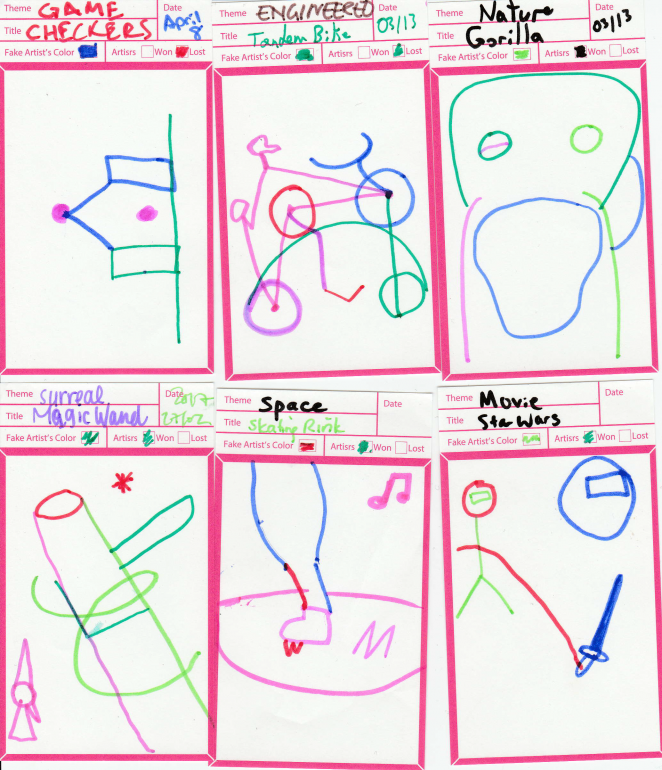Hello again and welcome, friends and well-wishers, to a second installment in the Extra-Curricular Play series where I will share some of the fun interactions that happen in TAG when we play games without it being explicitly tied to research. Beyond seeking to capture more of what happens around the lab for your reading pleasure, this article series emerges out of a desire to highlight that, as much as the folks around TAG love to work with games and game-y objects in a research context, they’re not afraid to roll up their sleeves, wipe the sweat from their brows, and gather to press some buttons or roll some dice just for kicks. Consider it a game review couched in anecdotal, blog-esque stories peppered with a few weak attempts at humour. Let’s dive right in, shall we?
The Game
A Fake Artist Goes to New York is a party-style game from Japanese company Oink Games and while some use the ‘party’ label in a derogatory sense, recent games like this or Vlaada Chvatil’s Codenames are showing that a game’s taking less than 3 hours to play or its being geared towards groups of more than 4 or 5 has no bearing on how much of a grand ol’ time you can have while playing it.
The rules are pretty straightforward: one player is the Question Master who selects something for the rest of the players to draw. This can be anything from a movie, to a household appliance, to an obtuse, abstract concept that most would fear to put to paper. All the other players are the artists, who give the QM a small piece of dry-erase cardboard (available in 10 dashing colour combos!) on which the QM will right exactly what is being drawn (Lion King, blender, dignity, etc…). The QM does so on all but one of the pieces of cardboard. On this last one, they simply draw an X. The QM then returns the cardboard pieces to their respective owners and everyone looks at what is on the drawing board for the round. The player with the X, aka the FAKE ARTIST, now finds themselves in a pickle – everyone knows what is being drawn but them. To help out with this, the QM offers a vague hint to the group of what the drawing’s genre or subject might be (movie, appliance, concept, etc…)
But here’s the rub – the players are all taking turns drawing their oeuvre together on a single (admittedly tiny) piece of paper one line at a time with colour-coded markers. As soon as one’s marker is lifted, their turn ends. After two rounds of players drawing line by line like this players must vote on who they think the fake artist is. If they are wrong, then the fake went undetected and wins (along with the QM). If, however, the fake is detected, then they have a chance to guess what was being drawn and only if they are incorrect do the ‘real’ artists win.

Credit to Boardgamegeek for the pic. Did I mention how CUTE the game is?!
What emerges from this is that the real artists want to be as vague as possible while still signaling to each other that they know what is supposed to be drawn while the fake artist can get away with being vague to a point but has to try and ‘play the room’ to figure out how best to fit in with the artwork. It’s a great twist to the usual verbal bluffing in hidden roles games that seems to mitigate some issues for all you bad liars out there.
The Museum of Fake Artistry – Star Wars Characters Wear Welding Helmets, Right?
My absolute favourite part of the game by far is that once you’re done with a slip of paper, you can file it away in the box and create your own museum of fake artistry and play. The game’s stationary even has a small rubrik at the top to help with the curation process. Every time you open the box to play, you get a trip down memory lane to that time when you thought someone was the fake artist because they gave Foucault a beard (when really they just didn’t know what he looked like) or the time when the fake artist had to go first and they were way to bold with their opening stroke.
Here’s a selection from a couple of TAG’s games:

The Verdict
Fake Artist pushes the party label further than most by requiring a minimum of 5 players and allowing for a maximum of 10 (or more if you have some spare dry-erase markers and cardboard) and this is simultaneously one of the game’s greatest strengths and weaknesses. While the game is definitely a ‘more the merrier’ kind of experience, having to recruit a minimum of 5 people means that I’ve found myself bringing it to a game night and not getting to play it more often than I’d like. Still, it’s not really a design problem that the game allows for fixing – like all good bluffing games, you do need at least a few people to cast suspicion onto! My only other real gripe is that the pieces are small and easy to lose, but that’s more a criticism of my own poor life choices than the designers’.
In the end, this tiny box is a great pickup for anyone who loves drawing, hates drawing, and/or has more than 3 other people that they wouldn’t mind playing a board game with. It’s a bit of a sleeper hit for me that I happened to stumble into a round of at DiGRA last summer and it was only a short while after that my copy was in the mail. I give it 47 weird-as-heck tandem bikes out of 52 and a half!
